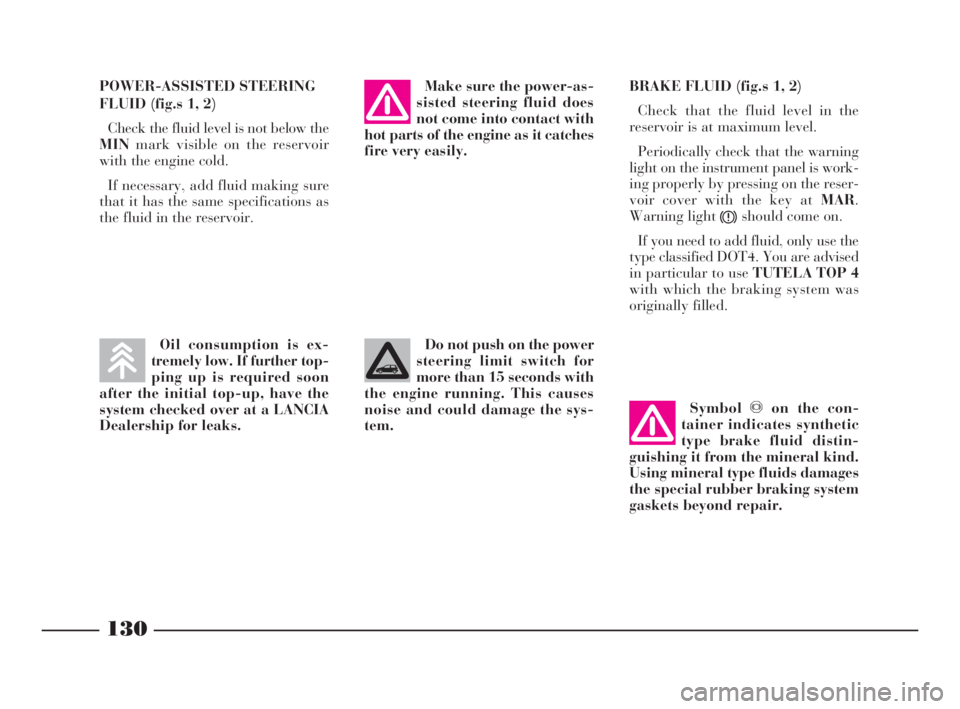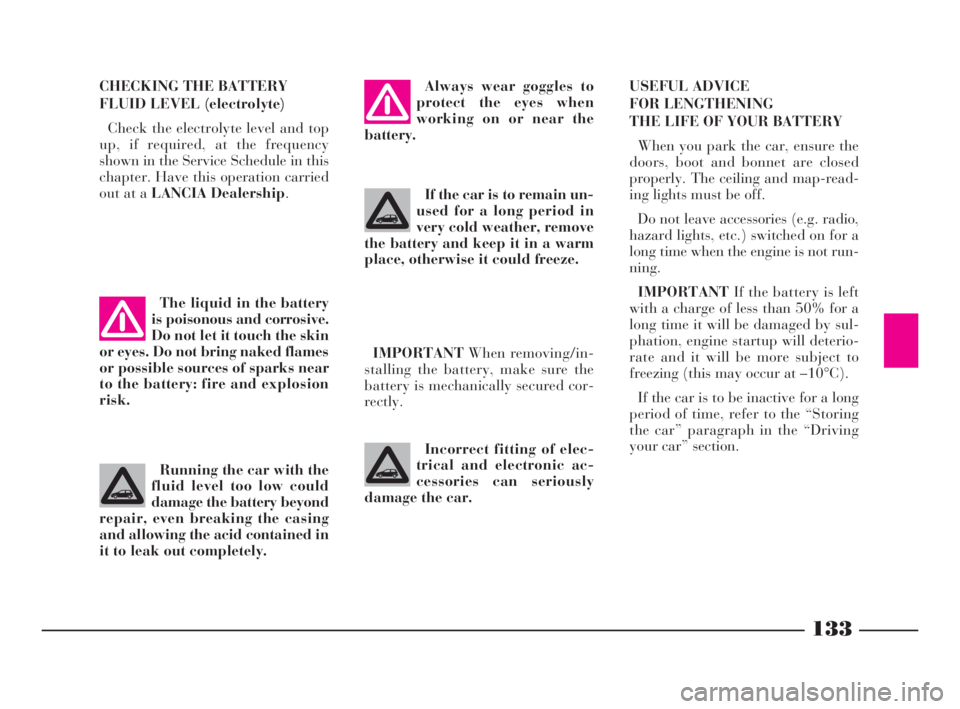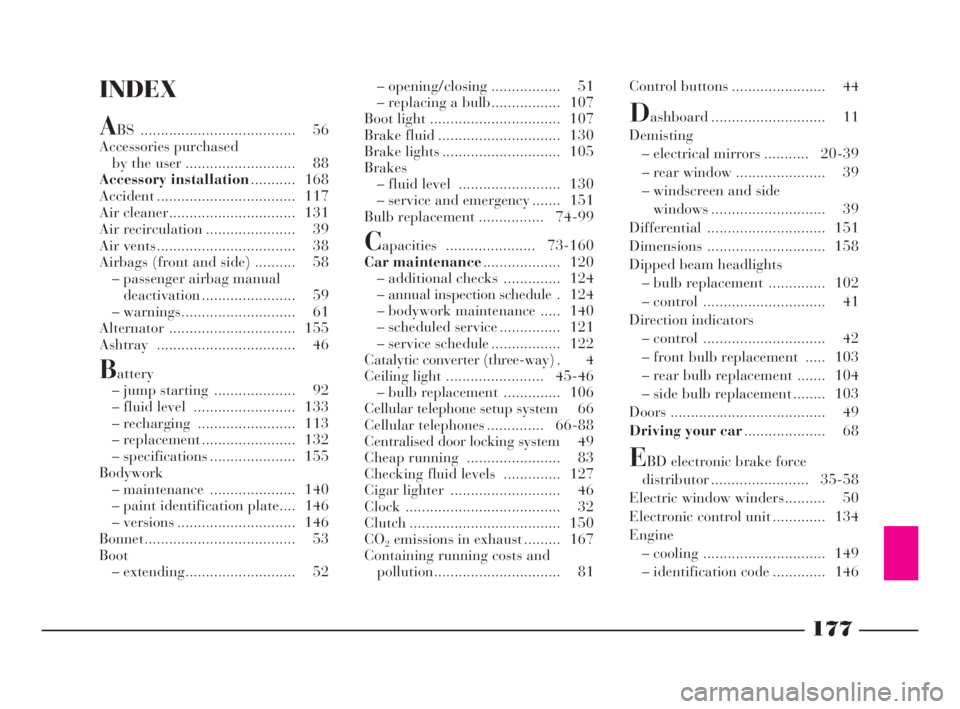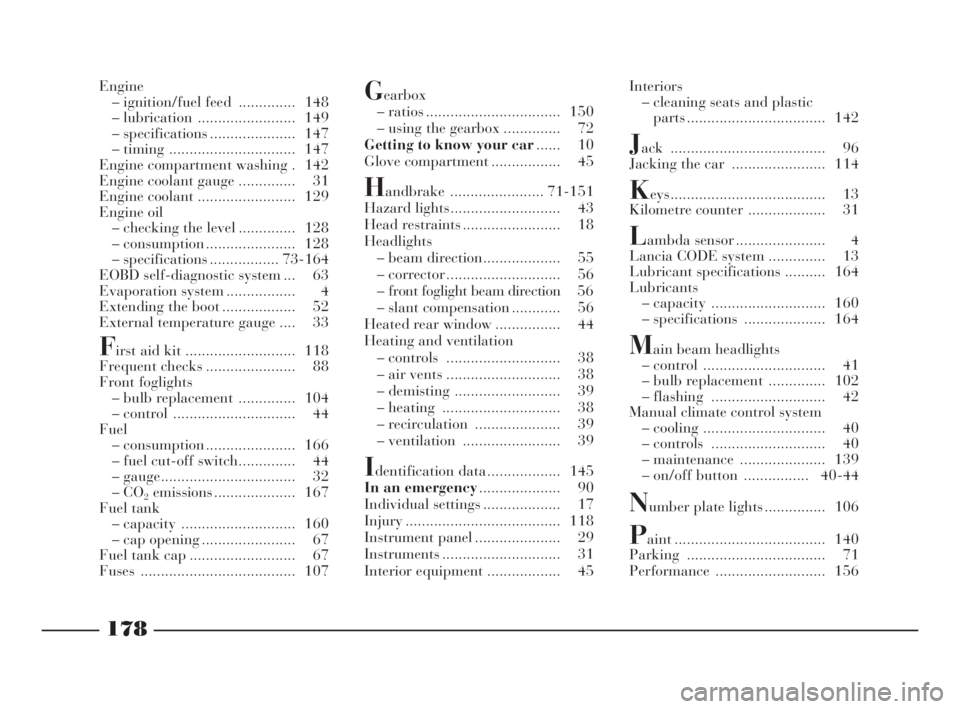light Lancia Ypsilon 2002 Owner handbook (in English)
[x] Cancel search | Manufacturer: LANCIA, Model Year: 2002, Model line: Ypsilon, Model: Lancia Ypsilon 2002Pages: 191, PDF Size: 2.45 MB
Page 133 of 191

130
G
POWER-ASSISTED STEERING
FLUID (fig.s 1, 2)
Check the fluid level is not below the
MINmark visible on the reservoir
with the engine cold.
If necessary, add fluid making sure
that it has the same specifications as
the fluid in the reservoir.BRAKE FLUID (fig.s 1, 2)
Check that the fluid level in the
reservoir is at maximum level.
Periodically check that the warning
light on the instrument panel is work-
ing properly by pressing on the reser-
voir cover with the key at MAR.
Warning light
xshould come on.
If you need to add fluid, only use the
type classified DOT4. You are advised
in particular to use TUTELA TOP 4
with which the braking system was
originally filled.
Symbolπon the con-
tainer indicates synthetic
type brake fluid distin-
guishing it from the mineral kind.
Using mineral type fluids damages
the special rubber braking system
gaskets beyond repair.
Make sure the power-as-
sisted steering fluid does
not come into contact with
hot parts of the engine as it catches
fire very easily.
Do not push on the power
steering limit switch for
more than 15 seconds with
the engine running. This causes
noise and could damage the sys-
tem.Oil consumption is ex-
tremely low. If further top-
ping up is required soon
after the initial top-up, have the
system checked over at a LANCIA
Dealership for leaks.
4C120-143 ING 11-03-2008 12:01 Pagina 130
Page 136 of 191

133
G
USEFUL ADVICE
FOR LENGTHENING
THE LIFE OF YOUR BATTERY
When you park the car, ensure the
doors, boot and bonnet are closed
properly. The ceiling and map-read-
ing lights must be off.
Do not leave accessories (e.g. radio,
hazard lights, etc.) switched on for a
long time when the engine is not run-
ning.
IMPORTANTIf the battery is left
with a charge of less than 50% for a
long time it will be damaged by sul-
phation, engine startup will deterio-
rate and it will be more subject to
freezing (this may occur at –10°C).
If the car is to be inactive for a long
period of time, refer to the “Storing
the car” paragraph in the “Driving
your car” section.
The liquid in the battery
is poisonous and corrosive.
Do not let it touch the skin
or eyes. Do not bring naked flames
or possible sources of sparks near
to the battery: fire and explosion
risk.
Incorrect fitting of elec-
trical and electronic ac-
cessories can seriously
damage the car.
IMPORTANTWhen removing/in-
stalling the battery, make sure the
battery is mechanically secured cor-
rectly.
Running the car with the
fluid level too low could
damage the battery beyond
repair, even breaking the casing
and allowing the acid contained in
it to leak out completely.
Always wear goggles to
protect the eyes when
working on or near the
battery.
If the car is to remain un-
used for a long period in
very cold weather, remove
the battery and keep it in a warm
place, otherwise it could freeze.
CHECKING THE BATTERY
FLUID LEVEL (electrolyte)
Check the electrolyte level and top
up, if required, at the frequency
shown in the Service Schedule in this
chapter. Have this operation carried
out at a LANCIA Dealership.
4C120-143 ING 11-03-2008 12:01 Pagina 133
Page 144 of 191

141
G
IMPORTANTCars with optional
“Kaleidos” options (non-standard
personalised paint colours), can be re-
paired in exactly the same way as
other cars painted with standard
colours at your LANCIA Dealership.To wash the car properly:
1)Remove the aerial from the roof
to prevent damaging it when washing
the car in an automatic carwash.
2)Wet the body using a low pressure
jet of water.
3)Wipe a sponge with a slightly
soapy solution over the bodywork,
frequently rinsing the sponge.
4)Rinse well with water and dry
with a jet of air or a chamois leather.
When drying the car, be careful to
get at those parts which are not so
easily seen e.g. the door frames, bon-
net and around the headlights where
water can most readily collect. You
are advised not to take the car into a
closed area immediately, but to leave
it out in the open so any water left can
evaporate more easily.
Do not wash the car after it has been
parked in the sun or while the bonnet
is hot: it could take the shine off the
paint.
External plastic parts must be
cleaned following the usual car wash-
ing procedure. As far as possible avoid parking your
car under trees; the resinous sub-
stances which often drop from certain
types of trees could dull the paint and
increase the possibility of rusting.
IMPORTANTBird droppings must
be washed off immediately and with
great care as their acid is particularly
aggressive.
Detergents pollute water.
For this reason, the car
must be washed in an area
equipped for the collection and
purification of the liquids used
while washing.
IMPORTANTWashing is to be car-
ried out with the engine cold and the
ignition key on STOP. After washing
make sure that the various protections
(rubber sheaths and other guards)
have not moved from their positions
or been damaged.
4C120-143 ING 11-03-2008 12:01 Pagina 141
Page 146 of 191

143
G
PLASTIC PARTS INSIDE
THE CAR
Use special products designed not to
alter the appearance of the compo-
nents.
IMPORTANTDo not use alcohol or
petrol for cleaning the glass of the in-
strument panel.CLEANING LEATHER SEATS
AND PARTS
– Remove the dry dirt with a buck-
skin or very slightly moist cloth with-
out exerting too much pressure.
– Remove liquid or grease stains
with a dry absorbent cloth without
rubbing. Then wipe with a buckskin
or soft cloth moistened with water and
neutral soap.
If the stain does not come out, use a
special cleaning compound being par-
ticularly careful to follow the instruc-
tions for use.
IMPORTANTNever use alcohol or
alcohol-base products.Do not keep aerosol cans
in the car. There is the risk
they might explode. Aerosol
cans must never be exposed to a
temperature above 50°C; when the
weather starts to get hot the tem-
perature inside the car might go
well beyond that figure.
Never use flammable
products (petroleum ether
or petrol) to clean the in-
side of the car. Electrostatic
charges generated by rubbing
while cleaning could cause fires.
4C120-143 ING 11-03-2008 12:01 Pagina 143
Page 172 of 191

169
G
SOUND SYSTEM/RADIO NAVIGATION SYSTEM
SET-UP SYSTEM WIRING
DIAGRAM AND ADDITIONAL
BRANCHES (SOUND SYSTEM)
(fig. 1)
A- Radio aerial;
B- Terminal box;
C- High-amp fuse box;
D- Front left speaker;
E- Left tweeter;
F- Right tweeter;
G- Front right speaker;
H- Radio;
I- Rear right speaker;
L- Rear left speaker;
M- CD CHANGER (where fitted)
wire with respectiving connector,
where you can install a compatible
CD CHANGER if required;
m- +30;
n- Code positive;
o- Radio lights positive.
List of cable colour codes
N=Black - R=Red - AG=Blue/Yellow - AR=Blue/Red - CV=Orange/Green
CN=Orange/Black - BN=White-Black - GN=Yellow-Black - NZ=Black-Purple
RG=Red-Yellow - RN=Red-Black - SN=Red-Black
fig. 1
P4C00388
4C168-176 ING 11-03-2008 12:03 Pagina 169
Page 173 of 191

170
G
List of cable colour codes
G=Yellow - N=Black - R=Red - AG=Blue/Yellow - AR=Blue/Red - BR=White/Red -
CV=Orange/Green - CN=Orange/Black - BN=White-Black - GN=Yellow-Black -
NZ=Black-PurpleRG=Red-Yellow - RN=Red-Black - SN=Red-Black
SET-UP SYSTEM WIRING
DIAGRAM AND ADDITIONAL
BRANCHES (RADIO
NAVIGATION SYSTEM) (fig. 2)
A- Radio aerial;
B- Terminal box;
C- High-amp fuse box;
D- Front left speaker;
E- Left tweeter;
F- Right tweeter;
G- Front right speaker;
H- Radio-navigator;
I- Rear right speaker;
L- Rear left speaker;
M- Vehicle speed signal;
N- GPS aerial;
O- Reversing signal;
P- CD CHANGER wire with re-
spectiving connector, where you can
install a compatible CD CHANGER if
required;
m- +30;
n- +15;
o- Radio lights positive.
fig. 2
P4C00423
4C168-176 ING 11-03-2008 12:03 Pagina 170
Page 175 of 191

172
G
ELECTRICAL CONNECTION
DIAGRAM (fig. 4)
1- Connection on the branching box
for powering the relays
2- Terminal box
3- Left taillight
4- Relay for the power supply of the
trailer’s left-hand direction indicator
5- Relay for the power supply of the
trailer’s right-hand direction indicator
6- Right taillight
7- 7-pole socket
8- Rear left grounding point
9- Connection between dashboard
cables and rear cables
10- 7.5A fuse
List of cable colour codes
B=White - G- Yellow - L=Blue- M=Brown- N=Black- R=Red- V=Green
TOW HITCH
fig. 4
P4C00170
4C168-176 ING 11-03-2008 12:03 Pagina 172
Page 176 of 191

173
G
For mechanical connections, the fol-
lowing must be used:
– “CUNA 501” 1
stclass ball coupling
(CUNA NC 138-40 table);
– “CUNA 501” 1
stclass socket cou-
pling (CUNA NC 438-40 table).For the electric connection a 7-pole,
12 Volt coupling must be used
(CUNA UNI 9128).
The electric coupling must be fixed
on a special mount to be attached to
the ball coupling.
The electrical functions for the cou-
pling must be connected as illustrated
in(fig. 5).
In addition to the electrical connec-
tions (illustrated in the diagram that
follows), only the lead for powering
an electric brake and the lead to
power a light inside the trailer not ex-
ceeding 15W may be connected to the
car’s electrical system.
The electric brake must be powered
directly from the battery by means of
a lead with a cross-section no less
than 2.5 sq. mm.
Location of the components
on the car:
1.Left taillight (rear foglight con-
nection) - 2.Right taillight (brake
lights connection) - 3.Pole socket -
4.Trailer direction indicators power
supply relays - 5.High-amp fusebox
-6.Branching box. TOW HITCH INSTALLATION
(fig. 5)
The tow hitch must be fixed to the
body by an expert in accordance with
the following instructions and with
any additional instructions or infor-
mation provided by the tow hitch
manufacturer.
fig. 5
P4C00416
4C168-176 ING 11-03-2008 12:03 Pagina 173
Page 180 of 191

177
fdG
INDEX
ABS ...................................... 56
Accessories purchased
by the user ........................... 88
Accessory installation........... 168
Accident .................................. 117
Air cleaner............................... 131
Air recirculation ...................... 39
Air vents.................................. 38
Airbags (front and side) .......... 58
– passenger airbag manual
deactivation ....................... 59
– warnings............................ 61
Alternator ............................... 155
Ashtray .................................. 46
Battery
– jump starting .................... 92
– fluid level ......................... 133
– recharging ........................ 113
– replacement ....................... 132
– specifications ..................... 155
Bodywork
– maintenance ..................... 140
– paint identification plate.... 146
– versions ............................. 146
Bonnet..................................... 53
Boot
– extending........................... 52– opening/closing ................. 51
– replacing a bulb................. 107
Boot light ................................ 107
Brake fluid .............................. 130
Brake lights ............................. 105
Brakes
– fluid level ......................... 130
– service and emergency ....... 151
Bulb replacement ................ 74-99
Capacities ...................... 73-160
Car maintenance................... 120
– additional checks .............. 124
– annual inspection schedule . 124
– bodywork maintenance ..... 140
– scheduled service ............... 121
– service schedule ................. 122
Catalytic converter (three-way) . 4
Ceiling light ........................ 45-46
– bulb replacement .............. 106
Cellular telephone setup system 66
Cellular telephones .............. 66-88
Centralised door locking system 49
Cheap running ....................... 83
Checking fluid levels .............. 127
Cigar lighter ........................... 46
Clock ...................................... 32
Clutch ..................................... 150
CO
2emissions in exhaust ......... 167
Containing running costs and
pollution............................... 81Control buttons ....................... 44
Dashboard ............................ 11
Demisting
– electrical mirrors ........... 20-39
– rear window ...................... 39
– windscreen and side
windows ............................ 39
Differential ............................. 151
Dimensions ............................. 158
Dipped beam headlights
– bulb replacement .............. 102
– control .............................. 41
Direction indicators
– control .............................. 42
– front bulb replacement ..... 103
– rear bulb replacement ....... 104
– side bulb replacement ........ 103
Doors ...................................... 49
Driving your car.................... 68
EBD electronic brake force
distributor ........................ 35-58
Electric window winders.......... 50
Electronic control unit ............. 134
Engine
– cooling .............................. 149
– identification code ............. 146
4C177-184 Indice ING 13-03-2008 13:31 Pagina 177
Page 181 of 191

178
fdG
Interiors
– cleaning seats and plastic
parts .................................. 142
Jack ...................................... 96
Jacking the car ....................... 114
Keys...................................... 13
Kilometre counter ................... 31
Lambda sensor ...................... 4
Lancia CODE system .............. 13
Lubricant specifications .......... 164
Lubricants
– capacity ............................ 160
– specifications .................... 164
Main beam headlights
– control .............................. 41
– bulb replacement .............. 102
– flashing ............................ 42
Manual climate control system
– cooling .............................. 40
– controls ............................ 40
– maintenance ..................... 139
– on/off button ................ 40-44
Number plate lights ............... 106
Paint ..................................... 140
Parking .................................. 71
Performance ........................... 156 Engine
– ignition/fuel feed .............. 148
– lubrication ........................ 149
– specifications ..................... 147
– timing ............................... 147
Engine compartment washing . 142
Engine coolant gauge .............. 31
Engine coolant ........................ 129
Engine oil
– checking the level .............. 128
– consumption ...................... 128
– specifications ................. 73-164
EOBD self-diagnostic system ... 63
Evaporation system ................. 4
Extending the boot .................. 52
External temperature gauge .... 33
First aid kit ........................... 118
Frequent checks ...................... 88
Front foglights
– bulb replacement .............. 104
– control .............................. 44
Fuel
– consumption ...................... 166
– fuel cut-off switch.............. 44
– gauge................................. 32
–CO
2emissions .................... 167
Fuel tank
– capacity ............................ 160
– cap opening ....................... 67
Fuel tank cap .......................... 67
Fuses ...................................... 107
Gearbox
– ratios ................................. 150
– using the gearbox .............. 72
Getting to know your car...... 10
Glove compartment ................. 45
Handbrake ....................... 71-151
Hazard lights........................... 43
Head restraints ........................ 18
Headlights
– beam direction................... 55
– corrector ............................ 56
– front foglight beam direction 56
– slant compensation ............ 56
Heated rear window ................ 44
Heating and ventilation
– controls ............................ 38
– air vents ............................ 38
– demisting .......................... 39
– heating ............................. 38
– recirculation ..................... 39
– ventilation ........................ 39
Identification data .................. 145
In an emergency.................... 90
Individual settings ................... 17
Injury ...................................... 118
Instrument panel ..................... 29
Instruments ............................. 31
Interior equipment .................. 45
4C177-184 Indice ING 13-03-2008 13:31 Pagina 178